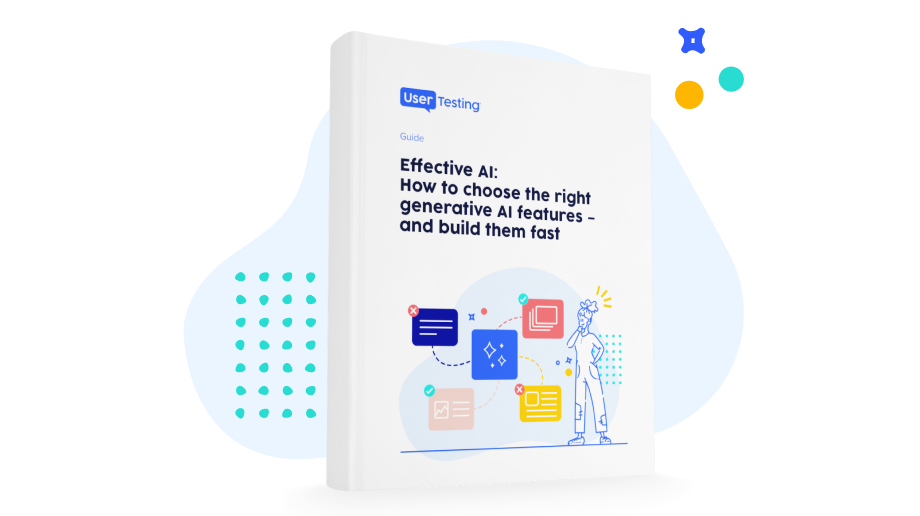
The most dangerous AI feature is the one you launched blind

The AI customer journey is here to stay, becoming a key element of the user experience in both retail and consumer sectors. From generative chatbots to product discovery and autonomous agents, implementing AI is no longer optional.
But despite pressure from competitors, building an AI feature that's actually useful to the end-user is a process that can't be rushed. In the race to incorporate AI in a business's UX, many organizations skip a crucial step: validating the customer experience.
An AI feature launched blind poses significant risks to user trust, product credibility, and brand perception. When customers don’t understand why an AI makes a recommendation, or when they feel the system is acting without their input, it can trigger disengagement or even backlash.
And trust, once lost, is difficult to regain.
Why high-performing features still fail
AI features often demonstrate strong technical performance through user engagement metrics. But conventional metrics like conversion rates, session duration, and average task completion time may indicate behavioral trends but fail to capture the emotional dimensions of the customer’s AI experience.
These metrics lack the granularity to explain why users respond positively or negatively to AI interactions. They can’t account for confusion caused by AI decision logic, discomfort with tone, or loss of trust.
For example, a product recommendation may receive a high click rate but still cause frustration if users feel manipulated.
According to a Salesforce Customer report, only 17% of global consumers are comfortable with AI making decisions on their behalf. And a Forrester study showed that only 29% trust information from generative AI. This gap between capability and customer confidence remains significant.
Features that lack transparency or context feel intrusive. A chatbot that is meant to foster conversational commerce may answer a customer query accurately but sound robotic. An assistant may make the right product suggestion, but at the wrong time.
These are not technical defects. They are failures of experience.
GUIDE
Designing AI-powered shopping experiences for the next generations of commerce
The risks of launching untested AI features
According to Gartner, global spending on generative AI is expected to reach $644 billion in 2025—yet without proper user testing, even a fraction of that investment risks being wasted.
The risks are not theoretical—they’re measurable, and they compound quickly:
- Financial risk. Poorly tested AI features can lead to revenue loss due to abandoned sessions, customer churn, and expensive post-launch rollbacks. Fixing broken features after launch often costs significantly more than validating them beforehand.
- Reputation damage. A single misguided AI interaction can cause lasting harm to brand credibility. Mistrust can spread quickly, especially if users feel deceived or misunderstood by an autonomous system.
- Wasted time and effort. Teams may spend weeks or months building AI functionality that ends up being scrapped or overhauled due to poor adoption. This results in missed go-to-market windows and sunk costs across engineering, design, and marketing.
- Increased support burden. Misaligned or confusing AI features can overwhelm support teams with avoidable customer service tickets, especially if the AI fails silently or doesn’t offer clear explanations.
Without direct customer feedback before launch, teams risk making critical decisions in the dark.
How to test AI features before launch
To align AI-driven experiences with customer expectations, organizations follow a structured approach to testing:
Build and simulate early
Create prototypes or mockups that simulate live experiences. Include edge cases and variations to reflect real-world complexity. Avoid waiting until development is complete.
Teams can use low-code platforms or design tools like Figma combined with UserTesting’s prototype testing to simulate different interaction paths.

Test in context
Conduct tests in realistic settings, such as mobile usage or multitasking scenarios. Context-specific testing helps surface usability and emotional issues not visible in lab environments.
This includes unmoderated tests on mobile where participants interact with the feature while doing everyday tasks, like commuting or cooking. Use screen recording and voiceover prompts to gather not only what users do, but what they think and feel in real time.
Measure both functionality and perception
Track metrics like task success and time to complete. More importantly, assess how users describe their experience. Frustration, confusion, or disinterest often signal issues beyond usability.
Use sentiment and friction tools to flag where trust or clarity breaks down. Combine that with quick surveys with open-ended questions to uncover both usability issues and deeper emotional barriers.
Iterate and validate
Incorporate insights into revisions, then re-test. Repeating the loop builds confidence that your AI supports customer goals and expectations.
Run rapid turn-around tests to check updates within days. Revalidation helps confirm that changes improved the experience across diverse user groups.
How Deezer tested their AI prototype with UserTesting
Deezer, a global music streaming platform, differentiates itself with Flow, a one-tap personalized music stream that adapts to user preferences and listening habits. But the team wanted to evolve it further using AI to adapt to emotional context. They needed Flow to answer not just what users wanted to hear, but why.

Deezer ran a global study interview with UserTesting focused on their casual listeners. With the study spanning six countries, Deezer revealed a key insight: casual listeners choose music based on mood rather than artist or genre.
With this insight, Deezer developed Flow Moods, a new emotion-based curation feature. They tested Figma prototypes with UserTesting, gathering real-time feedback on layout, design, and emotional clarity. Iterative testing allowed them to refine copy, interaction logic, and choice architecture without rebuilding test sessions.
As a result, Flow Moods launched to over one million users in its first month, with higher engagement and retention rates than other feature sets. By listening to real users early on, Deezer didn’t just build an AI feature; they created something people actually loved.
The human-centered future of AI
AI adoption is accelerating across retail and consumer industries, but its success depends on more than functionality. To earn trust and drive long-term adoption, AI features must be evaluated through the lens of real human experience.
Organizations that build AI in isolation risk falling behind—not because their technology is lacking, but because their experience is misaligned. Testing early, testing often, and using real human insight is no longer optional. It’s a strategic imperative.
Key takeaways:
- Metrics alone won’t uncover risk. Performance indicators tell part of the story, but without human context, they leave teams vulnerable to blind spots and internal assumptions.
- User feedback reveals the full picture. Watching how customers interact with AI shows where confusion, hesitation, or rejection happens—and why.
- Trust is a competitive advantage. Quick deployment is not enough. Companies that test for usability, clarity, and emotional tone are more likely to earn lasting loyalty.
- Validate early, not after the fact. Teams that bring customer insight into the prototyping phase move faster with fewer reworks—and launch features with confidence.
FAQ
Q: What makes AI feature testing different from traditional UX testing?
A: AI features are dynamic and contextual. Unlike static interfaces, they respond to user behavior in real time. This requires testing for tone, clarity, and trust—not just usability.
Q: How early should AI experiences be tested?
A: Testing should begin at the prototyping phase. Early validation allows for design improvements and ensures alignment across teams before development is complete.
Q: What should we look for when testing AI with customers?
A: Observe where users hesitate, disengage, or express confusion. Pay close attention to how the AI is interpreted. Does it feel helpful, or intrusive? Clear, or vague? These reactions shape long-term trust.

How to choose and develop the right AI features
Get actionable steps to help you get your AI development right on the first try.






